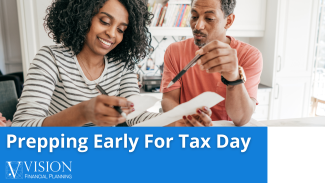
Prepping Early For Tax Day
Prepping Early For Tax Day
As the year comes to a close, probably the last thing on your mind is filing your taxes in spring. But if you start assembling the necessary documents and information now, you’ll experience less stress and be in a far better position come April. Luckily, tax day is a few days later than usual in 2023—since April 15 falls on a weekend, and the following Monday is a holiday, the deadline for filing this year’s taxes is April 18. So even if you don’t get a refund, you’ll at least have a later deadline!
Gather your tax documents and information
Preparation is the key to keeping any tax-filing stressors at bay, so you’ll want to check your inbox and mailbox regularly in the coming weeks. As employers are obligated to issue W-2s by January 31, you may be receiving important tax documents within a few weeks. Also be on the lookout for other important documents you’ll need for filing your taxes, such as 1099 forms reporting any investment income and 5498 forms noting contributions and rollovers to individual retirement accounts. If you expect to be receiving multiple tax documents, consider having a large envelope or basket that you can keep the documents in as they arrive in the mail and creating a system for storing the ones you receive digitally. This way nothing will get misplaced before you file your taxes. You will also need the social security numbers for yourself, your spouse, and any dependents, so make sure you know these or have them noted in a safe place. If you plan to use a preparer for your 2022 taxes, be aware that some will ask you to provide them with the necessary documentation by a certain date so they can meet the April 18 filing deadline.
Document your credits and deductions
Deductions can lower your taxes since they reduce your taxable income, so claim as many as you legally can. Gather documentation for any donations, expenses for medical care, mortgage interest, retirement account contributions, and local and state taxes you paid in 2022. Store these documents with your other tax documents. You will also want to organize your documentation for any tax credits you plan to claim, such as the child tax credit, the child and dependent care tax credit, credits for tuition paid for education, the “savers credit” for contributions to a 401(k) or IRA, and credits for any energy-saving home improvements you made in 2022.
Review your estimated tax payments
If you are a freelancer or own your own business, you may have made quarterly estimated tax payments on your earnings to the IRS during the year, which you will have to note when you file your taxes. To help make the process smoother, make sure you know how much these payments were in advance. You can check by looking back over your bank or credit card statements from this year.
Look ahead
If you really want to be an overachiever, once you’ve gathered all the documentation necessary for filing your 2022 taxes, you can start getting organized for 2023! Put a system together now for saving next year’s pertinent receipts and information so you’ll have them at the ready when you need to file your taxes in 2024.
Important Disclosures
The opinions voiced in this material are for general information only and are not intended to provide specific advice or recommendations for any individual.
This information is not intended to be a substitute for specific individualized tax advice. We suggest that you discuss your specific tax issues with a qualified tax advisor.
This article was prepared by ReminderMedia.
LPL Tracking #1-05352325

